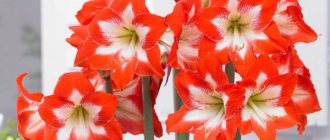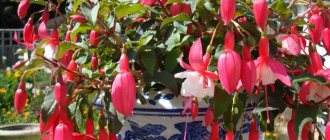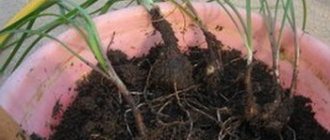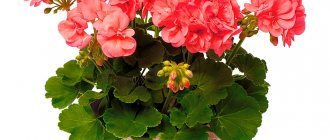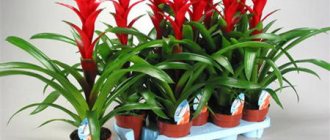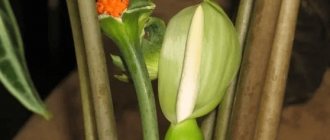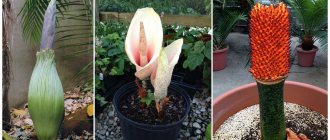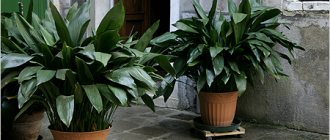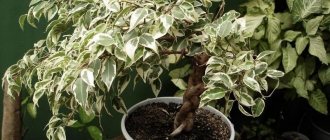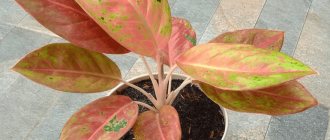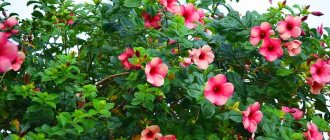Hippeastrums - Royal or Knight's Stars (literally - “star” and “horseman”) - bulbous perennials native to Latin America and South Africa. Tropical exotics belong to the Amaryllis family. Expressive graceful flowers on a thick, tall peduncle look like a festive bouquet composition. The forced culture is represented by many thousands of specimens. Today we will talk about the most picturesque and popular varieties of domestic hippeastrum.
Description of the plant
Hippeastrum is a genus of plants from the amaryllis family. In our climate it is grown as a houseplant, and its homeland is the tropics and subtropics of North and South America.
The name Hippeastrum comes from the Greek:
- the word hippeus means knight (horseman);
- astron means star.
Morphology:
- The bulbs are 5-12 cm in diameter and produce several evergreen leaves.
- The stem is straight, hollow, 50-60 cm high, usually supports up to four (in exceptional cases up to 6) large flowers.
- Flowers are 20-30 cm in diameter, up to 17 cm long, funnel-shaped, wide open. The flowers consist of 6 large perianth petals fused at the base, red, orange, pink, white. Twisted stamens grow from the center of the flower. Some have colored stripes on their petals. There are varieties with multi-colored flowers, for example, with white petals in the center and red on the edges. Flowers appear before leaves.
Hippeastrum flowering period: from December to June.
Hippeastrum is often mistakenly called amaryllis, confused with another plant from the amaryllis family - Amaryllis belladonna. Sellers are misleading by using the name amaryllis rather than the correct name, hippeastrum. Although both plants belong to the same Amaryllis family, they are 2 different species.
Attention! Hippeastrum is a very poisonous plant. Its juice causes skin irritation, and consumption of any part leads to severe food poisoning.
Plant differences table
| Hippeastrum | Amaryllis | |
| Number of flowers | 4 (rarely 6) | 10-12 |
| Stem | hollow | not hollow |
| Flowering period | winter, early spring | The end of the summer |
Hippeastrum is a very popular potted plant, both in mass production and for amateur cultivation at home. The species is also used as attractive and durable cut flowers; they last 7-14 days in a vase.
Types of hippeastrum
Hippeastrum was found for a long time exclusively in South America and nearby regions, but in the sixteenth century travelers brought it to Europe. Soon, gardeners appreciated the beautiful and spectacular flower, and years of selection and breeding began. The first hybrid appeared at the end of the eighteenth century - it was Johnson's hippeastrum. Let's find out more!
Hippeastrum hybrid
This is the common name for dozens of colorful varieties developed by breeders in recent years. The most common colors are red, pink, orange and their variations. Two-color varieties with contrasting stripes or spots look interesting. The flowers are large, up to 20 cm in diameter and 2-6 pieces on a high peduncle.
Photo: pot-flowers.ru
Hippeastrum teyucuarense
This is one of the most unusual varieties, notable for its interesting colors. The petals are arranged in tubular bells, green in the center and with bright red or pink edges. The transition from color to color is sharp and contrasting, and the middle resembles a star. All petals are covered with a mesh pattern of emerging veins.
Photo: pinterest.ru
Cavalier hippeastrum
This is the first species that was brought to Europe and began to be bred in closed botanical gardens. For a long time, cavalier hippeastrum was the star of private estates and flower farms. Soon, breeders became actively interested in the spectacular brick-red flowers.
Photo: 2sotki.ru
Hippeastrum Johnson
This is the brainchild of the English watchmaker Johnson, who back in the eighteenth century managed to cross the striped and royal amaryllis. By its nature, this is a hybrid species, therefore its name in the original is written accordingly: Hippeastrum x johnsonii.
Photo: garden7day.blogspot.com
Royal hippeastrum
This is a variety of medium height - up to 30-50 cm, but with excellent decorative properties. The petals are very pointed towards the edge, so they especially resemble a large star. Royal hippeastrum is traditionally a bright scarlet shade, so it will become a real decoration of any garden.
Photo: dailyherald.com
Columnar hippeastrum
This species is distinguished by very delicate and neat inflorescences, which are especially loved by florists and landscape designers. On one stem there are about 6-8 large tubular flowers diverging in different directions. The petals have a delicate peach-salmon hue with distinct thin brownish veins.
Photo: ttcomm.ru
Indoor begonia: home care, propagation and transplantation
Classification and varieties
There are about 80 species native to the tropical and subtropical climates of South America. There are evergreen species and deciduous ones that go through a dormant period. In our homes we usually grow hybrids; they are more popular and accessible.
Hippeastrum has been known for almost 200 years. Hippeastrum cultivation began in the Netherlands and Belgium already at the end of the 18th century. Species imported mainly from Brazil and Peru gave rise to the first cultivars. Progress in selection is so great that about 600 hybrids are now grown, differing in growth vigor, color, size, shape of flowers, and the number of flowers in the inflorescence. There are many varieties with lush flowers.
Over the years, the most famous varieties (65% of the total number of flowers sold in the world) include:
- "Red Lion" Red Lion - red;
- “Apple Blossom” Apple Blossom – white with pink stripes.
Based on the size and structure of flowers, a classification into 9 groups was created.
Below are popular groups and varieties with photos.
- Galaxy group - large simple flowers, about 15-16 cm in diameter.
| Benfica Benfica | "Clown" Clown |
- Diamond group - medium flowers with a diameter of 12-16 cm.
| "Charisma" Charisma | Lemon Lime |
- Colibri group - small single flowers with a diameter of less than 12 cm.
| "Baby Star" Baby Star | "Fairy Tail" Fairy Tail |
- Double Galaxy group - double large flowers with a diameter of more than 16 cm.
| Dancing Queen | Sweet Nymph |
- Double Diamond group - double flowers with a diameter of about 12-16 cm.
"Alfresco" Alfresco
- Spider group - flowers that resemble a spider in shape.
| "La Paz" La paz | "Rio Negro" Rio Negro |
- Butterfly group - flowers that resemble a butterfly in shape.
"Exotic Star" Exotic Star
- Double Colibri group - small double flowers with a diameter of less than 12 cm.
- Trumpet group - trumpet-shaped flowers, for example, "Misty" Misty, "Amputo" Amputo.
Flower varieties
There are no more than 2000 wild Hippeastrum species, together with hybrids bred on their basis. But only some of them are especially loved by gardeners, so they are bred more often than others.
Hippeastrum Leopoldii
An excellent option for those who want to focus attention on this plant. The main feature of this Hippeastrum is large double flowers on a dark green stalk. Their petals are painted in two colors: white and cherry. Although hybrids with other shades have been bred.
Hippeastrum Reticulatum
This species is rare in indoor floriculture, which is why you will almost certainly be surprised by such a plant. Again, the unique coloration plays a major role in the identity of the reticulated Hippeastrum.
Large petals come in bright colors: pink, red or even burgundy. But the coloring is not solid, but resembles a grid pattern. That is why, in fact, the variety was named that way.
Hippeastrum Reginae
A very common species that is easy to grow and blooms in relatively standard conditions in most rooms. It is only important that it is warm and has enough moisture.
The flowers of this species are entirely painted in one color. The most common colors are either red or white. Another name for this variety is Royal.
Amaryllis belladonna
This is originally a flower from a common family with Hippeastrum, but quite different from them. On the other hand, numerous hybrids, the basis for which was precisely this variety of Amyrillis, are already classified by botanists as Hippeastrum. And these species, it is worth recognizing, have a special flower shape, are well adapted to indoor conditions, bloom longer and are relatively undemanding in care.
What to look for when buying a bulb?
Hippeastrum bulbs appear on sale in the fall and are usually ready for planting, that is, they have passed a period of rest (rest). After purchasing, you can plant them immediately and patiently wait for the flowers to appear in a few weeks.
Advice: if it is not possible to plant the bulb immediately after purchase, you need to keep it in a cool (9-10 degrees C) and dry place.
Always choose firm and healthy bulbs without:
- signs of rotting;
- red spots;
- mechanical damage;
- holes around the heel.
Dry scales can be torn off; sometimes foci of fungal diseases are found underneath them.
The bulb should have several healthy roots, not dry and crumbling threads.
You can buy planting material in different sizes, but the minimum size for a good quality bulb is 24-26cm in circumference and will probably produce one flower shoot. If the bulb is too small, it is better not to buy it.
The rule is this: the larger the bulb, the more flower shoots it will produce. It is often recommended to buy bulbs with a minimum circumference of 20 cm.
The size of planting material depends on the variety. Varieties with small flowers may have smaller bulbs.
For large-flowered varieties, it is better to plant larger bulbs:
- from bulbs with a circumference of 24-26 cm, plants with one shoot are obtained;
- with a circumference of 28-30 cm they form 2, 3 inflorescences.
Varieties with small flowers give:
- 2 shoots from bulbs with a circumference of 24-26 cm;
- 1 shoot – from bulbs 20-22 cm.
After about 7 years, the viability of the planting material begins to decline, the plants bloom less frequently and less spectacularly, so it is worth buying several new bulbs periodically.
Botanical structure of a double flower
This is a perennial plant with pear-shaped or spindle-shaped bulbs with a diameter of up to 12 cm. The bulb produces 1-2 leafless peduncles 40–70 cm long.
Each peduncle can have from 2 to 6 flowers, which consist of many double petals, which give them a special volume and beauty.
The leaves of the plant are flat, 3 cm wide and grow in two rows. They are dark green in color and reach 70 cm in length.
Amaryllis Nymph buds come in a wide variety of colors:
- white;
- pink;
- red;
- burgundy;
- two-color.
Landing
When to plant?
Hippeastrum can be planted from October to May. Planting material is planted in the ground a month before the planned flowering date. It is preferable to plant the plant when daylight hours begin to noticeably lengthen - from the end of December. The longer the daylight hours, the more abundant the flowering.
Advice. If you purchased several bulbs, do not plant them at once, but at intervals of about two weeks. Then they will not bloom at the same time and will delight you with flowers longer.
For those who want to get a blooming hippeastrum for Christmas, the Christmas Gift and Merry Christmas varieties have been specially bred - ideal Christmas gifts for lovers of potted flowers.
Preparing the bulbs
Before planting, the bulbs should be rinsed for a few minutes in warm water to prevent the development of nematodes. During washing, the dry upper scales usually come off, and a beautiful light green bulb appears to our eyes if it is healthy. After washing, before planting, you should treat the planting material with a fungicide and wait until it dries.
Soil preparation
The optimal substrate for hippeastrum should be:
- humus;
- permeable;
- disinfected;
- with pH 6-7.
You can use ready-made mixtures of so-called universal soil for indoor plants and add garden chalk and perlite to it. Peat and coarse sand mixed in a volume ratio of 1:1:1 can be added to the substrate.
In an acidic substrate with a pH less than 5.5, hippeastrum takes root poorly and flowering is delayed. Therefore, it is recommended to maintain the pH at 6-7. Calcium deficiency affects shoot fragility. Before planting, the substrate should be watered abundantly.
Choosing a pot
The pot for hippeastrum should be slightly larger than the bulbs. When choosing a suitable container, it is necessary to take into account the rather large size of the bulbs, which can reach 20 centimeters in diameter.
The pot is selected so that there is a distance of 2 fingers (about 4 cm) between the bulb and the edges of the container on each side.
Containers must have drainage holes; be sure to add a drainage layer (expanded clay, small pebbles) to the bottom.
Planting, post-planting care
We do not bury the bulb deeply so that leaves and peduncles can grow freely from the top. Plant so that 1/3 of the bulb sticks above the ground. Some gardeners plant even half above the ground. After planting, press the soil firmly around the bulb to ensure it is stable. If the bulb is very large, it is better to insert the pot into a heavier base.
Immediately after planting, carry out the first, abundant watering and transfer the pot to a warm place with a temperature of 20-23 degrees, with plenty of light. An east or west window sill will work well. In the following days, water moderately. Hippeastrum grows quite quickly if it has access to sunlight and heat.
We maintain this state until the hippeastrum begins to bloom. When the flowers appear, we look for a slightly cooler place for it and water it more. Thanks to these two procedures, the plant will be able to better color the flowers.
Rest period
The leaves of the flower turn yellow and droop - the plant is preparing for a period of rest. Trim the dried leaves, stop watering and fertilizing, and move the flower pot to a dry, cool and dark place with a temperature of 10-13 degrees. Hippeastrum rests from September to December. At this time, the bulb should not be allowed to dry out, so water the plant with a tray once a month.
Important! Hippeastrum forcing and dormancy are closely related. The better conditions are organized for the dormant period, the more successful the forcing of the plant to flower will be.
Hippeastrum varieties with white flowers are popular in Western countries as part of Christmas home decor.
Growing and care
Hippeastrum is a plant of medium difficulty to grow. It requires regular watering, providing conditions suitable for development and rest (rest). With proper care, it will reward you with decorative flowers. The most common problem when growing hippeastrum is the lack of flowering. This is usually due to an incorrect regime - lack of a rest period or drying out of the bulb after flowering. Let's figure out how to care for the plant and what it needs to bloom.
The plant prefers warm, bright, sunny places and will also grow in partial shade. The more sun rays fall on the hippeastrum, the larger the inflorescences it forms.
During growth, it is worth turning the pot every few days - this will ensure full growth of the stem, without the risk of bending towards the sun. Dry air does not threaten the plant, but it needs a lot of heat.
Watering
After planting, water the hippeastrum moderately, especially if there are no well-formed roots. When a flower shoot appears, watering should be increased, but in moderation.
We water hippeastrum only from below, pouring water into the stand under the pot; watering from above causes the bulb to rot.
Flowering, feeding
Hippeastrum blooms depending on the time of planting from December to June. This is the most beautiful period in the life of a plant and, unfortunately, compared to other plants, it is short. Flowering can last 1-2 weeks.
During flowering, it is recommended to move the plant to a cooler place and not expose it to direct sunlight. In such conditions, flowers last longer. During flowering, we feed the hippeastrum with fertilizers for flowering plants and water as needed.
Photo. Flowers of various hybrids
| "Gervase" Gervase | "Sumatra" Sumatra |
| "Evegreen" Evergreen | Lemon Lime |
| "Tosca" Tosca | "Terracotta Star" Terracotta Star |
| "Ixpause" Exposure | Tres Chic |
| "Monaco" Monaco | "Spotlight" Spotlight |
| "Papilio" Papilio | "Ambience" Ambiance |
Care after flowering
This is the least pleasing time to the eye when we are growing leaves and feeding the bulb. However, you need to know how to care for hippeastrum after flowering. If you do not plan to propagate hippeastrum from seeds, then you should not allow them to set. After flowering, remove the flowers! We tear them off from the peduncle, which we do not remove yet. It will nourish the bulb for some time. The peduncle is removed only after it dries.
Leaves begin to grow from the bulb. Until the end of summer we grow hippeastrum with leaves. From flowering to yellowing and wilting of leaves, care must be taken to ensure that the plant has:
- nutrition;
- water;
- enough light.
During this period, we apply fertilizer for green plants once a week. If possible, we place the pots in the garden or on the balcony, in a quiet sunny place, but not directly in the sun. Ideally, you need to place the pots under a canopy so that rain does not flood the hippeastrum. It is better to control watering yourself.
During this period, the bulbs increase in size, grow leaves, and form the rudiments of inflorescences for the next season. We take care of the hippeastrum in this way until the end of August, then we stop fertilizing and reduce watering. When the leaves begin to turn yellow, stop watering and wait until they dry out.
Experienced flower growers advise that if the leaves do not want to turn yellow and dry out in the fall, you need to reduce watering to a complete stop and, if the leaves do not dry out by mid-September, take the hippeastrum to the attic. When the leaves are completely dry, they are cut off.
Rest period
After the leaves have dried, the hippeastrum goes into a dormant state. This period lasts 2.5-3 months depending on the storage temperature. Experienced gardeners recommend keeping the plant alone for at least 3 months so that the hippeastrum is suitable for growing next season.
You can store the bulbs in two ways:
- In pots with a dry substrate and only after waking up, transplant into fresh soil.
- Remove them from the pots, clean them of soil, check their condition and store them in sawdust. You should carefully pry the bulb so that when removing it the heel with roots does not come off; first you need to trim the leaves a few centimeters above the bulbs.
The storage location for hippeastrum bulbs should be:
- dark;
- dry;
- cool (with a temperature of 8-15 degrees C).
If you store them at a higher temperature, the dormant period is shortened. As soon as the flower bud appears, we transplant the hippeastrum into a fresh substrate and repeat the growing cycle.
In order for the hippeastrum to bloom again, the bulb must be cooled at a temperature of 3-7 ⁰C. Flowers will appear before the end of December if in October you place the bulb in the refrigerator for several weeks in a plastic bag with holes cut for ventilation. Every few days you need to take the bulb out for a few minutes and ventilate it, this prevents mold from occurring.
In industrial production, bulbs are stored for 10 weeks at a temperature of 13 ° C and a humidity of 70-80%, and 10 days before planting at a temperature of 23-25 ° C, which accelerates plant growth.
Usually hippeastrums themselves show us the cycle:
- when it’s time to plant them (flower shoots begin to appear),
- when to ensure dormancy (the leaves begin to turn yellow, usually this happens in August).
You can control flowering by shortening the dormant period and regulating the temperature, this is done by experienced gardeners.
Why doesn't it bloom?
The plant blooms annually, but sometimes it happens that there is no flowering. Let's look at the main reasons why hippeastrum does not bloom and what to do in this case:
- The bulb did not receive enough nutrition . After flowering, the dying peduncle is cut off. Green leaves are left. You still need to continue to water and feed the plant so that it accumulates nutrients in the bulb for the next season.
- Lack of peace . At the end of summer - beginning of autumn, the hippeastrum should go into a dormant state; watering should be gradually reduced. The leaves will turn yellow and dry out. When the leaves are dry, move the pot to a room with a temperature of about 10 degrees Celsius and stop watering. In order for it to bloom again, it needs to be left alone for 3 months.
- Improper planting and care . In November or December, the bulbs should be removed from the ground, carefully cleaned and planted in a new substrate. Hippeastrum does not tolerate stagnation of water around the roots. The bulb needs to be buried 2/3 -1/3 in the ground, it should protrude above the ground. Move the pot to a warm place (preferably around 25 degrees C), water moderately.
- Lack of light . When the bud appears, move the plant to a well-lit, warm place and keep it indoors. We water gradually more. The water should be at room temperature. We begin fertilizing with multi-component fertilizer. Approximately 50-55 days after “awakening”, flowers should develop.
Garden care
If we have looked at home care for hippeastrum in sufficient detail, then it’s time to look at the plant in the open air. As we remember, in the wild the flower does not grow in greenhouse conditions, but still in warm ones. A temperate climate also benefits the plant. The flower is planted in the spring, when the earth has warmed up. The bulbs will have to be dug up for the winter, as they will not survive it. They are stored without leaves and roots, having carefully removed the latter.
Many gardeners note that hippeastrum blooms more readily in open ground, and the bulbs increase significantly in size. Considering that the plant is perennial, a strong and healthy bulb is the key to regularly flowering decoration of your garden.
The characteristic appearance of Hippeastrum belladonna: pointed petals of cool pink color, bowed flower
Hippeastrums are perennial flowers; they are planted in open garden soil in the spring, when the earth has already warmed up, and the bulbs are dug up for the winter.
Reproduction
Hippeastrum is propagated by daughter bulbs - children. In December - January, the mother bulb usually produces 1-2 additional bulbs. Small bulbs are separated from the mother bulb when they have their own roots. Small bulbs are planted in small pots and grown without a dormant period for about 3 years.
Hippeastrum can be propagated by seeds. Such plants do not repeat the varietal characteristics of the mother plant, but can produce interesting and new hybrids. You can pollinate different varieties and create your own hybrids, but you need to wait 3-4 years before the first flowering. Hippeastrum seeds are sown immediately after collection. Hippeastrums obtained from seeds are grown for 3 years without a dormant period.
Signs and superstitions associated with Hippeastrum
There are many beliefs and signs associated with Hippeastrum:
- If you ask a man to give him a Hippeastrum bulb and try to grow it, you can find out about the man’s feelings. A flowering plant means that a woman who has received a gift is dear to a man. A dead flower represents the coldness of a lover.
- The plant is considered the patron of travel. If you whisper over him the places you want to go, you may soon be able to get to them.
- Hippeastrum can also help single men. If you start growing a flower at home, then this is a good sign that in the near future you will have a close acquaintance with a spectacular woman.
- They say this plant is able to absorb negativity and then emits it. Therefore, it is not advisable to quarrel near a pot of Hippeastrum.
- Hippeastrum is recommended for people in creative professions to grow. They say that this particular indoor plant can charge with inspiration and instill inner confidence in a person.
- You can grow this plant anywhere in the house except the bedroom. Hippeastrum is a symbol of energy, initiative, and determination. Unfortunately, such a charge is unlikely to allow you to fall asleep and get enough sleep peacefully.
Pests and diseases
The following pests most often attack hippeastrum:
- Narcissus fly (Lampetiaequestris ) - its larvae destroy the insides of the bulb. Insects are active from spring until the end of June, so until then it is better not to take the plants outside.
- Thrips feed on leaves. Symptoms include silvering of leaves and black lumps of droppings.
Common diseases of hippeastrum:
- Red spot is a fungal disease caused by the fungus Phoma narcisii (synonym Stagonospora curtisii). Symptoms: red spots on onion skins, roots, base of leaves. This is the most dangerous and most difficult disease to fight. Fungicides can be used, but there is no guarantee of getting rid of the fungus. The fungus spreads quickly, causing slow growth and death. The development of the disease is favored by cold temperatures and excessive deepening of the bulb during planting.
- Rotting of roots and bulbs - the cause of the disease is too wet a substrate, excessive watering. Rotting parts can be removed, a fungicide applied, or the substrate changed. Rotting stains can be sprinkled with cinnamon after cleaning.
- Mosaic disease is a virus that causes discoloration and streaking on leaves and flowers. The diseased plant must be destroyed.
Buying hippeastrum in a pot
Bulbs are available for sale already planted in a pot, often with flowering shoots. To enjoy them longer, you need to replant them in a good substrate. Typically, growers plant them in coir and place them too deep in the substrate. After the bulb is taken out, it sometimes turns out that it is flooded with water and rots. If the peduncle is just emerging, you can replant it with extreme caution. If it blooms, replant after flowering.
If you do not decide to replant, place the pot in a warm, dry place, refrain from watering, and remove any rotting scales located above the ground. Buying a flowering plant is convenient, then we are confident in the variety.
Hippeastrum – photo
If you like to always have colorful bouquets at home, then hippeastrum is your choice. Unlike cut flowers, you definitely won't throw it away after a week. And it will become a real decoration of any interior!
Photo: oir.mobi Photo: dekormyhome.ru Photo: oir.mobi Photo: fb.ru
Photo: cosmosandcleome.wordpress.com
Photo: nn.ru
Photo: oir.mobi
Photo: 2sotki.ru Photo: domashniecvety.ru
Photo: dachaklub.ru Photo: 2sotki.ru Photo: prorastet.ru
Photo: domashniecvety.ru
Photo: dekormyhome.ru Photo: stocvetov.ru Photo: tchudesa.ru
Photo: pocvetam.ru
Photo: proprikol.ru
Photo: procvety.net Photo: oir.mobi
Photo: mkdou19.ru
Photo: liveinternet.ru Photo: oir.mobi
Photo: olx.kz
Photo: pot-flowers.ru
Photo: grounde.ru
Photo: flori-da.ru
Geranium: home care, propagation and transplantation
Use for bouquets
Hippeastrum flowers are cut off when the first buds of the inflorescence have visible color, but have not yet opened. Immediately after a short cooling at a temperature of 8-10 degrees. The inflorescences are wrapped in thin paper, then packed in cardboard boxes with a soft lining of 12, 15, 18 pieces.
Flowers that need to be stored are placed in a refrigerator in water at 10-12 °C or without water at 8-10 °C, but only for 2-3 days. At lower temperatures the flowers turn blue. The shoots break easily in water (since they are hollow inside), so after sorting, producers often wrap them with waterproof adhesive tape. Otherwise, cracked shoots must be greatly shortened before selling.
Summary
Until recently, hippeastrums were considered unfashionable plants. They are now experiencing a renaissance. We have a huge number of varieties to choose from. The largest supplier of hippeastrum is the Netherlands, where interesting, original varieties are bred. The growing area of this plant in the Netherlands is about 100 hectares. The plant is popular mainly because of the low labor costs in its cultivation, and even in winter, when light is scarce, good quality flowers can be produced.
Photo. Presentation of new varieties at an exhibition in the Netherlands
Contrary to appearances, this plant is not difficult to grow. The only problem is finding a suitable place to store the bulbs during the dormant period. Not everyone has a cool, dry room.
Pink hippeastrums: 3 delicate varieties
Estella. The variety is known for its clear, rich pink hue, which is not so often found in hippeastrums. The flowers are tubular in shape and decorated with clear white stripes. The pedicels are relatively long, slightly drooping, the perianth tube is 11-15 cm long. The greenish throat literally glows, very impressive.
Hippeastrum (amaryllis) Estella
Paris. Tall variety, about 80 cm tall. It is distinguished by water stains along the edges of the petals in a lavender-pink hue. The petals are tightly adjacent to each other, the flower is flat, saucer-shaped.
Hippeastrum (amaryllis) Paris
Rebecca. Tubular, medium, pure pink new variety of hippeastrum (launched 2022). The stamens are long, the throat is greenish, very beautiful.
Hippeastrum (amaryllis) Rebecca
